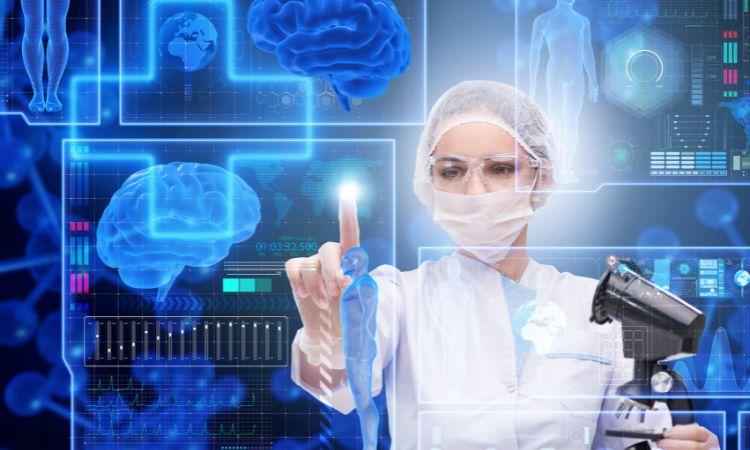The global clinical diagnostics market size attained a value of more than USD 63.41 billion in 2023. The market is further expected to grow in the forecast period of 2024-2032 at a CAGR of around 6.73% to reach a value of over USD 93.75 billion by 2032. This staggering growth reflects the increasing importance of clinical diagnostics in modern healthcare. Accurate and timely diagnosis is the cornerstone of effective medical treatment, and recent years have witnessed a revolutionary transformation in this field, thanks to the advent of artificial intelligence (AI).
In this blog post, we will explore the significant role that AI plays in revolutionizing clinical diagnostics. We’ll delve into the current state of clinical diagnostics, the ways in which AI is transforming the industry, the benefits it brings, as well as the challenges and ethical considerations associated with its implementation. Additionally, we will discuss future trends and developments, highlighting the potential impact of AI on patient care and outcomes.
The Current State of Clinical Diagnostics
Traditional Diagnostic Methods and Their Limitations
For many years, clinical diagnostics heavily relied on traditional methods, such as microscopy, blood tests, and tissue biopsies. While these methods have been instrumental in diagnosing a wide range of medical conditions, they come with inherent limitations. These limitations include:
- Subjectivity: Many diagnostic processes involve human interpretation, which can introduce subjectivity and variability in results.
- Time-Consuming: Traditional methods often require extended periods to deliver results, which can delay treatment decisions.
- Limited Scalability: As healthcare demands continue to grow, traditional methods may struggle to keep up with the volume of diagnostic tests required.
- Risk of Errors: Manual errors can occur during sample handling, analysis, and result reporting.
Challenges in Clinical Diagnostics
In addition to the limitations of traditional methods, clinical diagnostics face various challenges in the modern healthcare landscape:
- Complexity: The growing understanding of diseases at the molecular level demands more sophisticated diagnostic techniques.
- Data Overload: The sheer volume of medical data generated today can overwhelm healthcare professionals.
- Costs: Healthcare costs are rising, and efficient diagnostic methods are needed to optimize resource utilization.
- Treatment Personalization: Tailoring treatments to individual patients requires precise and reliable diagnostic information.
The Need for Innovation and Technological Advancements
To address these challenges and limitations, the clinical diagnostics industry has been actively seeking innovative solutions. This is where artificial intelligence comes into play. AI offers the potential to revolutionize clinical diagnostics by providing faster, more accurate, and scalable diagnostic tools.
How AI is Transforming Clinical Diagnostics
Overview of AI and Its Applications in Healthcare
Artificial intelligence encompasses a range of technologies that enable machines to perform tasks that typically require human intelligence, such as learning, reasoning, problem-solving, and decision-making. In healthcare, AI has found applications in areas like medical imaging, natural language processing, predictive analytics, and robotics.
AI-Powered Diagnostic Tools and Their Capabilities
AI-powered diagnostic tools leverage machine learning algorithms and deep learning models to analyze vast amounts of medical data quickly and accurately. Here are some examples of AI applications in clinical diagnostics:
-
Medical Imaging: AI algorithms can analyze medical images, such as X-rays, MRIs, and CT scans, to detect abnormalities and assist radiologists in making more accurate diagnoses.
-
Clinical Decision Support: AI systems can provide healthcare professionals with real-time decision support, helping them choose the most appropriate diagnostic tests and treatment options based on patient data and medical guidelines.
-
Predictive Diagnostics: AI can predict disease risk and progression by analyzing patient data, genetic information, and environmental factors, enabling early intervention and personalized treatment plans.
Case Studies Showcasing Successful AI Implementations in Diagnostics
To better understand the impact of AI in clinical diagnostics, let’s explore a few real-world examples:
Example 1: AI in Radiology
AI-powered image analysis tools have significantly improved the accuracy of radiological diagnoses. For instance, a study published in the journal Nature reported that an AI system outperformed human radiologists in detecting breast cancer from mammograms. The AI system’s ability to analyze thousands of images quickly led to faster and more reliable diagnoses.
Example 2: Genomic Diagnostics
Genomic diagnostics, which involve analyzing a patient’s DNA to identify genetic mutations and predispositions to diseases, have also benefited from AI. AI algorithms can sift through vast genomic data sets to identify relevant genetic markers associated with diseases like cancer, leading to more targeted and personalized treatment plans.
Example 3: Predictive Analytics
AI is increasingly used for predictive analytics in clinical diagnostics. By analyzing patient electronic health records (EHRs) and historical data, AI algorithms can predict disease outbreaks, patient readmissions, and treatment responses. This helps healthcare providers allocate resources effectively and tailor interventions to individual patient needs.
Benefits of AI in Clinical Diagnostics
The integration of AI into clinical diagnostics offers several notable advantages:
Improved Accuracy and Reliability of Diagnoses
AI algorithms excel at pattern recognition and can detect subtle abnormalities that might be missed by human observers. This leads to more accurate and reliable diagnoses, reducing the likelihood of false positives and false negatives.
Faster Turnaround Times for Test Results
AI-powered diagnostic tools can process and analyze data rapidly, significantly reducing the time required to generate test results. This speed is crucial for critical medical conditions where timely intervention is essential.
Enhanced Decision Support for Healthcare Professionals
AI systems can provide healthcare professionals with evidence-based recommendations, aiding in clinical decision-making. This not only improves diagnostic accuracy but also helps clinicians choose the most appropriate treatment options.
Cost-Effectiveness and Resource Optimization
By streamlining diagnostic processes and reducing errors, AI can lead to cost savings in healthcare. Additionally, it optimizes resource utilization by prioritizing high-risk patients and directing resources where they are most needed.
Challenges and Ethical Considerations
While the potential of AI in clinical diagnostics is promising, it also brings forth several challenges and ethical considerations that must be addressed:
Data Privacy and Security Concerns
AI systems require access to vast amounts of patient data, raising concerns about data privacy and security. Healthcare organizations must implement robust data protection measures to safeguard patient information.
Regulatory Hurdles and Compliance
The regulatory landscape for AI in healthcare is still evolving. Healthcare providers and AI developers must navigate complex regulations to ensure compliance with healthcare standards and patient safety requirements.
Ensuring Transparency and Fairness in AI-Driven Diagnoses
AI algorithms can be complex and often referred to as “black boxes” because their decision-making processes may not be fully explainable. Ensuring transparency in AI-driven diagnoses and addressing biases within algorithms is crucial to building trust among healthcare professionals and patients.
Future Trends and Developments
As we look ahead, it’s clear that AI will continue to play a pivotal role in the clinical diagnostics landscape. Some future trends and developments to watch for include:
Predictions for the Future of AI in Clinical Diagnostics
Industry experts predict continued growth in AI adoption, with more healthcare organizations integrating AI-powered diagnostic tools into their workflows. This will lead to further improvements in diagnostic accuracy and efficiency.
Integration of AI with Other Emerging Technologies
AI is likely to synergize with other emerging technologies, such as genomics, wearable devices, and telemedicine. This integration will enable a more holistic approach to healthcare, focusing on personalized treatment and prevention.
Potential Impact on Patient Care and Outcomes
Ultimately, the widespread use of AI in clinical diagnostics has the potential to revolutionize patient care and outcomes. Faster and more accurate diagnoses can lead to earlier interventions, more effective treatments, and improved patient outcomes.



